Economy of Australia - Assignment
VerifiedAdded on 2021/05/30
|25
|4500
|66
AI Summary
Contribute Materials
Your contribution can guide someone’s learning journey. Share your
documents today.
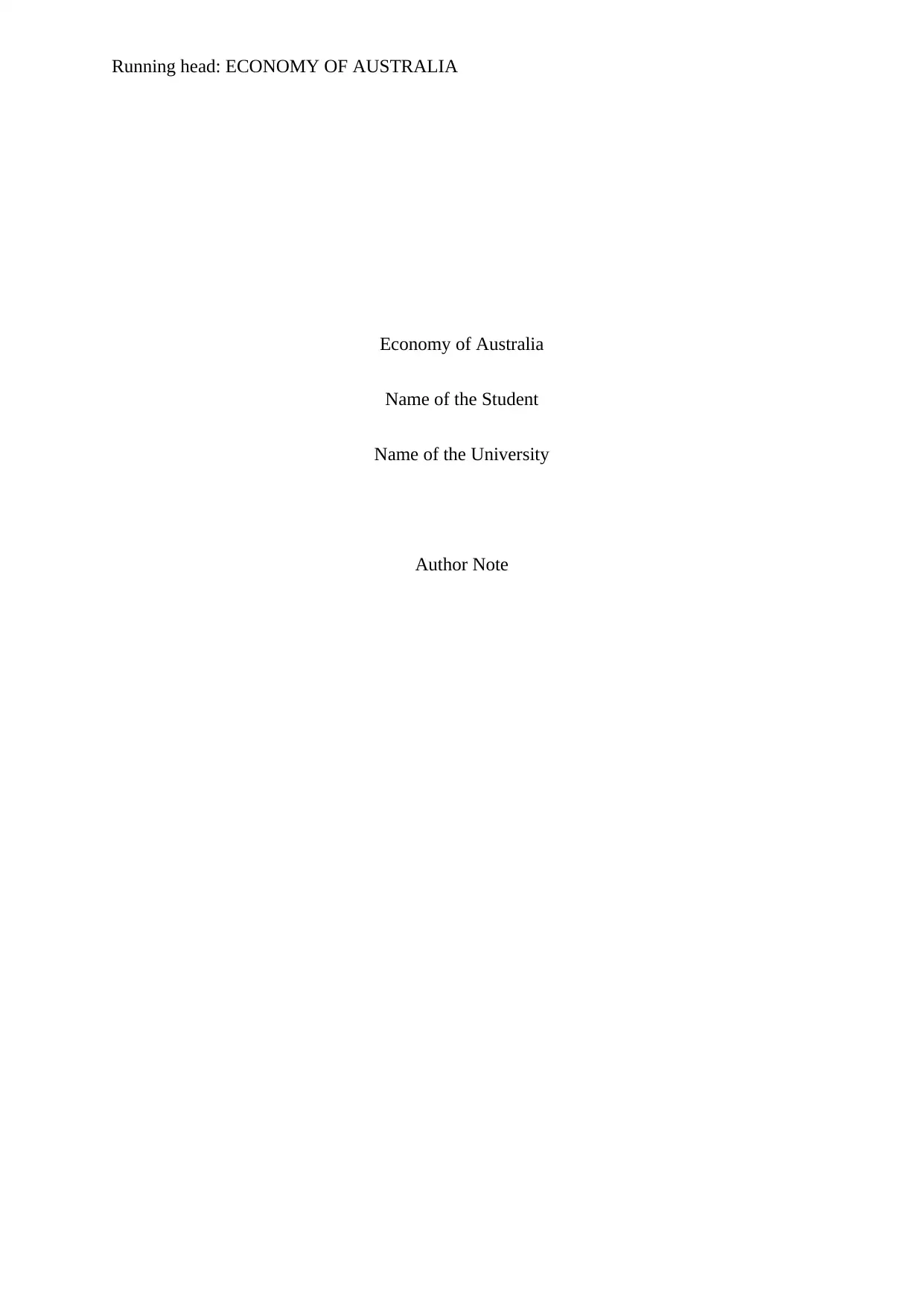
Running head: ECONOMY OF AUSTRALIA
Economy of Australia
Name of the Student
Name of the University
Author Note
Economy of Australia
Name of the Student
Name of the University
Author Note
Secure Best Marks with AI Grader
Need help grading? Try our AI Grader for instant feedback on your assignments.
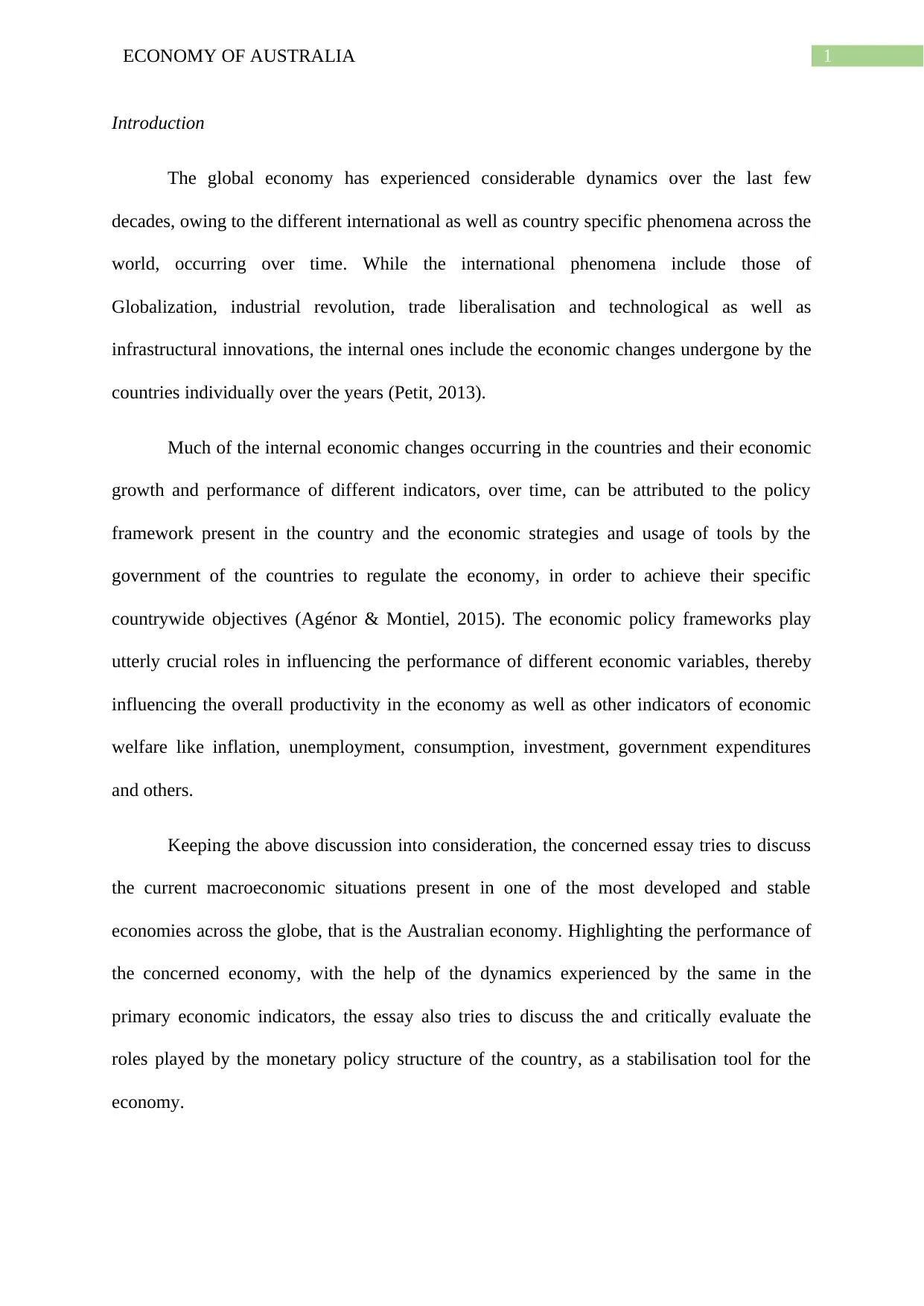
1ECONOMY OF AUSTRALIA
Introduction
The global economy has experienced considerable dynamics over the last few
decades, owing to the different international as well as country specific phenomena across the
world, occurring over time. While the international phenomena include those of
Globalization, industrial revolution, trade liberalisation and technological as well as
infrastructural innovations, the internal ones include the economic changes undergone by the
countries individually over the years (Petit, 2013).
Much of the internal economic changes occurring in the countries and their economic
growth and performance of different indicators, over time, can be attributed to the policy
framework present in the country and the economic strategies and usage of tools by the
government of the countries to regulate the economy, in order to achieve their specific
countrywide objectives (Agénor & Montiel, 2015). The economic policy frameworks play
utterly crucial roles in influencing the performance of different economic variables, thereby
influencing the overall productivity in the economy as well as other indicators of economic
welfare like inflation, unemployment, consumption, investment, government expenditures
and others.
Keeping the above discussion into consideration, the concerned essay tries to discuss
the current macroeconomic situations present in one of the most developed and stable
economies across the globe, that is the Australian economy. Highlighting the performance of
the concerned economy, with the help of the dynamics experienced by the same in the
primary economic indicators, the essay also tries to discuss the and critically evaluate the
roles played by the monetary policy structure of the country, as a stabilisation tool for the
economy.
Introduction
The global economy has experienced considerable dynamics over the last few
decades, owing to the different international as well as country specific phenomena across the
world, occurring over time. While the international phenomena include those of
Globalization, industrial revolution, trade liberalisation and technological as well as
infrastructural innovations, the internal ones include the economic changes undergone by the
countries individually over the years (Petit, 2013).
Much of the internal economic changes occurring in the countries and their economic
growth and performance of different indicators, over time, can be attributed to the policy
framework present in the country and the economic strategies and usage of tools by the
government of the countries to regulate the economy, in order to achieve their specific
countrywide objectives (Agénor & Montiel, 2015). The economic policy frameworks play
utterly crucial roles in influencing the performance of different economic variables, thereby
influencing the overall productivity in the economy as well as other indicators of economic
welfare like inflation, unemployment, consumption, investment, government expenditures
and others.
Keeping the above discussion into consideration, the concerned essay tries to discuss
the current macroeconomic situations present in one of the most developed and stable
economies across the globe, that is the Australian economy. Highlighting the performance of
the concerned economy, with the help of the dynamics experienced by the same in the
primary economic indicators, the essay also tries to discuss the and critically evaluate the
roles played by the monetary policy structure of the country, as a stabilisation tool for the
economy.
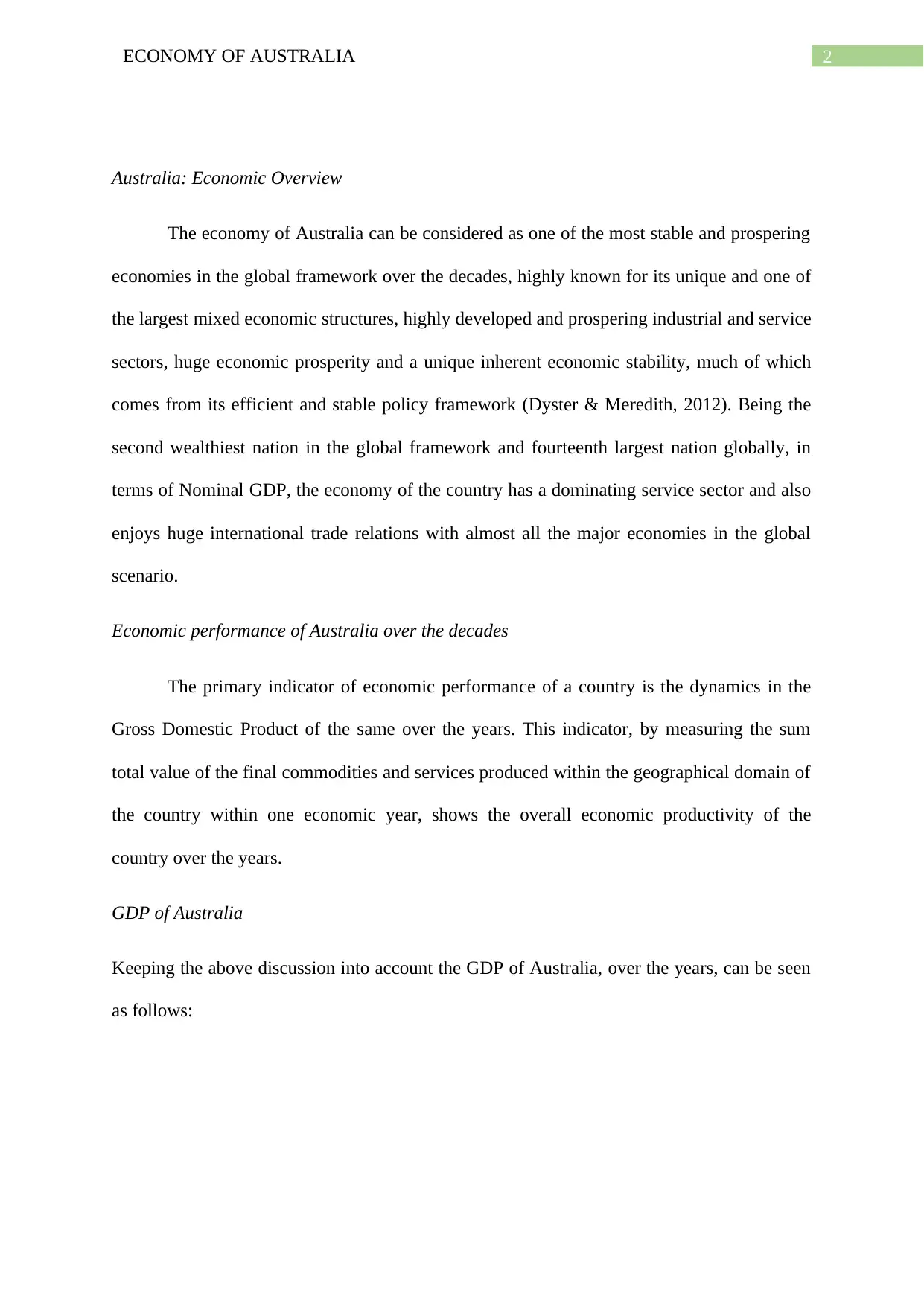
2ECONOMY OF AUSTRALIA
Australia: Economic Overview
The economy of Australia can be considered as one of the most stable and prospering
economies in the global framework over the decades, highly known for its unique and one of
the largest mixed economic structures, highly developed and prospering industrial and service
sectors, huge economic prosperity and a unique inherent economic stability, much of which
comes from its efficient and stable policy framework (Dyster & Meredith, 2012). Being the
second wealthiest nation in the global framework and fourteenth largest nation globally, in
terms of Nominal GDP, the economy of the country has a dominating service sector and also
enjoys huge international trade relations with almost all the major economies in the global
scenario.
Economic performance of Australia over the decades
The primary indicator of economic performance of a country is the dynamics in the
Gross Domestic Product of the same over the years. This indicator, by measuring the sum
total value of the final commodities and services produced within the geographical domain of
the country within one economic year, shows the overall economic productivity of the
country over the years.
GDP of Australia
Keeping the above discussion into account the GDP of Australia, over the years, can be seen
as follows:
Australia: Economic Overview
The economy of Australia can be considered as one of the most stable and prospering
economies in the global framework over the decades, highly known for its unique and one of
the largest mixed economic structures, highly developed and prospering industrial and service
sectors, huge economic prosperity and a unique inherent economic stability, much of which
comes from its efficient and stable policy framework (Dyster & Meredith, 2012). Being the
second wealthiest nation in the global framework and fourteenth largest nation globally, in
terms of Nominal GDP, the economy of the country has a dominating service sector and also
enjoys huge international trade relations with almost all the major economies in the global
scenario.
Economic performance of Australia over the decades
The primary indicator of economic performance of a country is the dynamics in the
Gross Domestic Product of the same over the years. This indicator, by measuring the sum
total value of the final commodities and services produced within the geographical domain of
the country within one economic year, shows the overall economic productivity of the
country over the years.
GDP of Australia
Keeping the above discussion into account the GDP of Australia, over the years, can be seen
as follows:

3ECONOMY OF AUSTRALIA
Figure 1: GDP of Australia (2000-2018)
(Source: Tradingeconomics.com, 2018)
As can be seen from the above figure, over the last two decades, the economic
productivity of Australia has maintained an overall increasing trend, barring the years from
2013, in which the trend of the same can be seen to be somewhat declining, signalling
towards a comparative stagnation of the economy in the last few years (Dyster & Meredith,
2012).
Figure 2: GDP growth rate of Australia (2000-2018)
(Source: Tradingeconomics.com, 2018)
Figure 1: GDP of Australia (2000-2018)
(Source: Tradingeconomics.com, 2018)
As can be seen from the above figure, over the last two decades, the economic
productivity of Australia has maintained an overall increasing trend, barring the years from
2013, in which the trend of the same can be seen to be somewhat declining, signalling
towards a comparative stagnation of the economy in the last few years (Dyster & Meredith,
2012).
Figure 2: GDP growth rate of Australia (2000-2018)
(Source: Tradingeconomics.com, 2018)
Secure Best Marks with AI Grader
Need help grading? Try our AI Grader for instant feedback on your assignments.

4ECONOMY OF AUSTRALIA
The GDP growth dynamics of the country can also be seen to be experiencing
considerable fluctuations, both positive as well as negative, over the years, which with their
alternative trends points towards the presence of business cycle in the economy. The growth
rate of GDP of the country can however be seen to be showing tampered trends in the last
few years, thereby pointing towards the stagnancy which the economy has been experiencing
in terms of productivity over the last few years (especially post 2010) (Gibson-Graham,
Cameron & Healy, 2013).
However, apart from GDP, the economy of a country and its performance, the overall
economic scenario of a country also depends on other factors and can be shown with the help
of other macroeconomic indicators, which in case of Australia can be seen as follows:
Inflation Rate in Australia
One of the primary macroeconomic indicators of welfare and performance of any
economy id the rate of inflation prevailing in the economy, which shows dynamics in the
average price levels of commodities prevailing in the country over the years. Keeping this
into account, the rate of inflation and its dynamics in the economy of Australia, over the last
few decades can be seen as follows:
Figure 3: Rate of inflation in Australia (2000-2018)
(Source: Tradingeconomics.com, 2018)
The GDP growth dynamics of the country can also be seen to be experiencing
considerable fluctuations, both positive as well as negative, over the years, which with their
alternative trends points towards the presence of business cycle in the economy. The growth
rate of GDP of the country can however be seen to be showing tampered trends in the last
few years, thereby pointing towards the stagnancy which the economy has been experiencing
in terms of productivity over the last few years (especially post 2010) (Gibson-Graham,
Cameron & Healy, 2013).
However, apart from GDP, the economy of a country and its performance, the overall
economic scenario of a country also depends on other factors and can be shown with the help
of other macroeconomic indicators, which in case of Australia can be seen as follows:
Inflation Rate in Australia
One of the primary macroeconomic indicators of welfare and performance of any
economy id the rate of inflation prevailing in the economy, which shows dynamics in the
average price levels of commodities prevailing in the country over the years. Keeping this
into account, the rate of inflation and its dynamics in the economy of Australia, over the last
few decades can be seen as follows:
Figure 3: Rate of inflation in Australia (2000-2018)
(Source: Tradingeconomics.com, 2018)
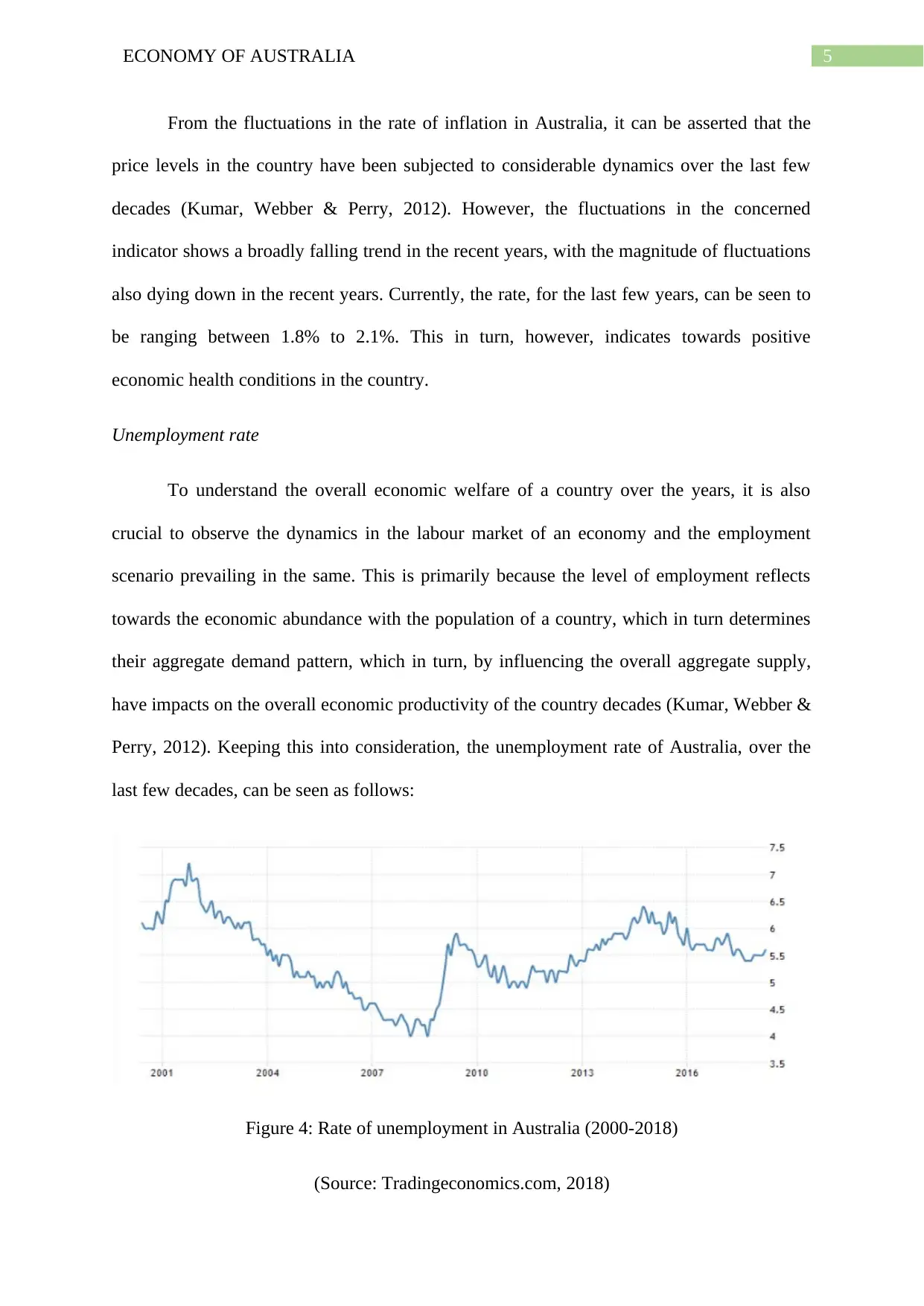
5ECONOMY OF AUSTRALIA
From the fluctuations in the rate of inflation in Australia, it can be asserted that the
price levels in the country have been subjected to considerable dynamics over the last few
decades (Kumar, Webber & Perry, 2012). However, the fluctuations in the concerned
indicator shows a broadly falling trend in the recent years, with the magnitude of fluctuations
also dying down in the recent years. Currently, the rate, for the last few years, can be seen to
be ranging between 1.8% to 2.1%. This in turn, however, indicates towards positive
economic health conditions in the country.
Unemployment rate
To understand the overall economic welfare of a country over the years, it is also
crucial to observe the dynamics in the labour market of an economy and the employment
scenario prevailing in the same. This is primarily because the level of employment reflects
towards the economic abundance with the population of a country, which in turn determines
their aggregate demand pattern, which in turn, by influencing the overall aggregate supply,
have impacts on the overall economic productivity of the country decades (Kumar, Webber &
Perry, 2012). Keeping this into consideration, the unemployment rate of Australia, over the
last few decades, can be seen as follows:
Figure 4: Rate of unemployment in Australia (2000-2018)
(Source: Tradingeconomics.com, 2018)
From the fluctuations in the rate of inflation in Australia, it can be asserted that the
price levels in the country have been subjected to considerable dynamics over the last few
decades (Kumar, Webber & Perry, 2012). However, the fluctuations in the concerned
indicator shows a broadly falling trend in the recent years, with the magnitude of fluctuations
also dying down in the recent years. Currently, the rate, for the last few years, can be seen to
be ranging between 1.8% to 2.1%. This in turn, however, indicates towards positive
economic health conditions in the country.
Unemployment rate
To understand the overall economic welfare of a country over the years, it is also
crucial to observe the dynamics in the labour market of an economy and the employment
scenario prevailing in the same. This is primarily because the level of employment reflects
towards the economic abundance with the population of a country, which in turn determines
their aggregate demand pattern, which in turn, by influencing the overall aggregate supply,
have impacts on the overall economic productivity of the country decades (Kumar, Webber &
Perry, 2012). Keeping this into consideration, the unemployment rate of Australia, over the
last few decades, can be seen as follows:
Figure 4: Rate of unemployment in Australia (2000-2018)
(Source: Tradingeconomics.com, 2018)

6ECONOMY OF AUSTRALIA
As is evident from the above figure, the rate of unemployment in Australia, which can
be seen to be at a considerably high rate (7.3%) in 2000-2001, can be seen to be steadily
decreasing till 2007 (4%). However, post 2007, the rate can be seen to be strikingly
increasing till 2010, much of which can be attributed to the Global Financial Crisis of 2008-
2008. The rate can be seen to be hovering around 5.5% in the recent years, with not much
fluctuations in the current periods, with the present rate of unemployment being existing at a
moderate level.
Consumption Expenditures in Australia
The economic wellbeing of the population of a country can to a considerable extent,
be seen from the dynamics in the aggregate demand situations present in the country, which
in turn, is influenced by the purchasing power and consumption expenditures of the
population of the country. Keeping this into consideration, the consumption expenditures of
the residents of Australia over the last two decades can be seen from the following figure:
Figure 5: Consumption Expenditures of Australia (2000-2018)
(Source: Tradingeconomics.com, 2018)
The consumption spending of the population of Australia, over the last two decades
can be seen to be stably increasing over the last two decades, which can however be because
As is evident from the above figure, the rate of unemployment in Australia, which can
be seen to be at a considerably high rate (7.3%) in 2000-2001, can be seen to be steadily
decreasing till 2007 (4%). However, post 2007, the rate can be seen to be strikingly
increasing till 2010, much of which can be attributed to the Global Financial Crisis of 2008-
2008. The rate can be seen to be hovering around 5.5% in the recent years, with not much
fluctuations in the current periods, with the present rate of unemployment being existing at a
moderate level.
Consumption Expenditures in Australia
The economic wellbeing of the population of a country can to a considerable extent,
be seen from the dynamics in the aggregate demand situations present in the country, which
in turn, is influenced by the purchasing power and consumption expenditures of the
population of the country. Keeping this into consideration, the consumption expenditures of
the residents of Australia over the last two decades can be seen from the following figure:
Figure 5: Consumption Expenditures of Australia (2000-2018)
(Source: Tradingeconomics.com, 2018)
The consumption spending of the population of Australia, over the last two decades
can be seen to be stably increasing over the last two decades, which can however be because
Paraphrase This Document
Need a fresh take? Get an instant paraphrase of this document with our AI Paraphraser
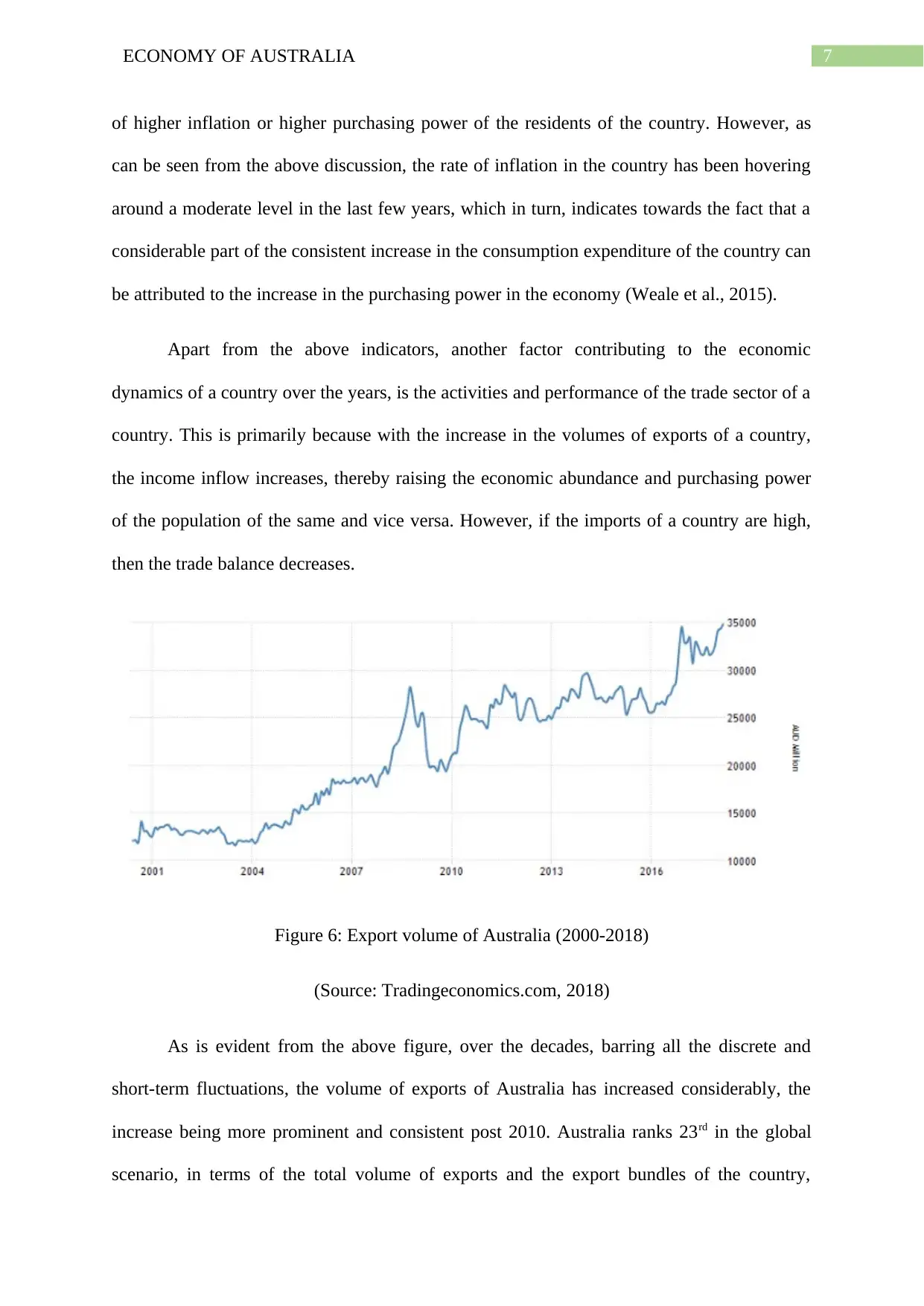
7ECONOMY OF AUSTRALIA
of higher inflation or higher purchasing power of the residents of the country. However, as
can be seen from the above discussion, the rate of inflation in the country has been hovering
around a moderate level in the last few years, which in turn, indicates towards the fact that a
considerable part of the consistent increase in the consumption expenditure of the country can
be attributed to the increase in the purchasing power in the economy (Weale et al., 2015).
Apart from the above indicators, another factor contributing to the economic
dynamics of a country over the years, is the activities and performance of the trade sector of a
country. This is primarily because with the increase in the volumes of exports of a country,
the income inflow increases, thereby raising the economic abundance and purchasing power
of the population of the same and vice versa. However, if the imports of a country are high,
then the trade balance decreases.
Figure 6: Export volume of Australia (2000-2018)
(Source: Tradingeconomics.com, 2018)
As is evident from the above figure, over the decades, barring all the discrete and
short-term fluctuations, the volume of exports of Australia has increased considerably, the
increase being more prominent and consistent post 2010. Australia ranks 23rd in the global
scenario, in terms of the total volume of exports and the export bundles of the country,
of higher inflation or higher purchasing power of the residents of the country. However, as
can be seen from the above discussion, the rate of inflation in the country has been hovering
around a moderate level in the last few years, which in turn, indicates towards the fact that a
considerable part of the consistent increase in the consumption expenditure of the country can
be attributed to the increase in the purchasing power in the economy (Weale et al., 2015).
Apart from the above indicators, another factor contributing to the economic
dynamics of a country over the years, is the activities and performance of the trade sector of a
country. This is primarily because with the increase in the volumes of exports of a country,
the income inflow increases, thereby raising the economic abundance and purchasing power
of the population of the same and vice versa. However, if the imports of a country are high,
then the trade balance decreases.
Figure 6: Export volume of Australia (2000-2018)
(Source: Tradingeconomics.com, 2018)
As is evident from the above figure, over the decades, barring all the discrete and
short-term fluctuations, the volume of exports of Australia has increased considerably, the
increase being more prominent and consistent post 2010. Australia ranks 23rd in the global
scenario, in terms of the total volume of exports and the export bundles of the country,

8ECONOMY OF AUSTRALIA
primarily consist of minerals, ores, natural gas and others. However, the country is also a
major importer in the global framework, ranking among the top five global importers. The
country imports automobiles, technological commodities and others, with the import volumes
exceeding that of exports many a times, which can be often seen to generate negative trade
balance in the country, as can be seen from the following figure:
Figure 7: Trade Balance of Australia (2000-2018)
(Source: Tradingeconomics.com, 2018)
In spite of increasing and considerably high volumes of export, the trade balance of
Australia can be seen to be negative in most of the years, barring a few years like 2001, 2011
and the last few years, where the same can be seen to be somewhat positive. This negative
balance of trade can be higher volumes of import in the country than the volumes of exports.
However, the consistently flourishing industrial sector, which contributes significantly
to overall development of the economy, can be seen to be experiencing a paradigm shift,
from manufacturing sector industries to the service sector ones, much of which can be
attributed to the increasing formation of capital in the country over the last few years, with
the increase in the level of investment in the country over the last few decades, which can be
seen from the following figure:
primarily consist of minerals, ores, natural gas and others. However, the country is also a
major importer in the global framework, ranking among the top five global importers. The
country imports automobiles, technological commodities and others, with the import volumes
exceeding that of exports many a times, which can be often seen to generate negative trade
balance in the country, as can be seen from the following figure:
Figure 7: Trade Balance of Australia (2000-2018)
(Source: Tradingeconomics.com, 2018)
In spite of increasing and considerably high volumes of export, the trade balance of
Australia can be seen to be negative in most of the years, barring a few years like 2001, 2011
and the last few years, where the same can be seen to be somewhat positive. This negative
balance of trade can be higher volumes of import in the country than the volumes of exports.
However, the consistently flourishing industrial sector, which contributes significantly
to overall development of the economy, can be seen to be experiencing a paradigm shift,
from manufacturing sector industries to the service sector ones, much of which can be
attributed to the increasing formation of capital in the country over the last few years, with
the increase in the level of investment in the country over the last few decades, which can be
seen from the following figure:
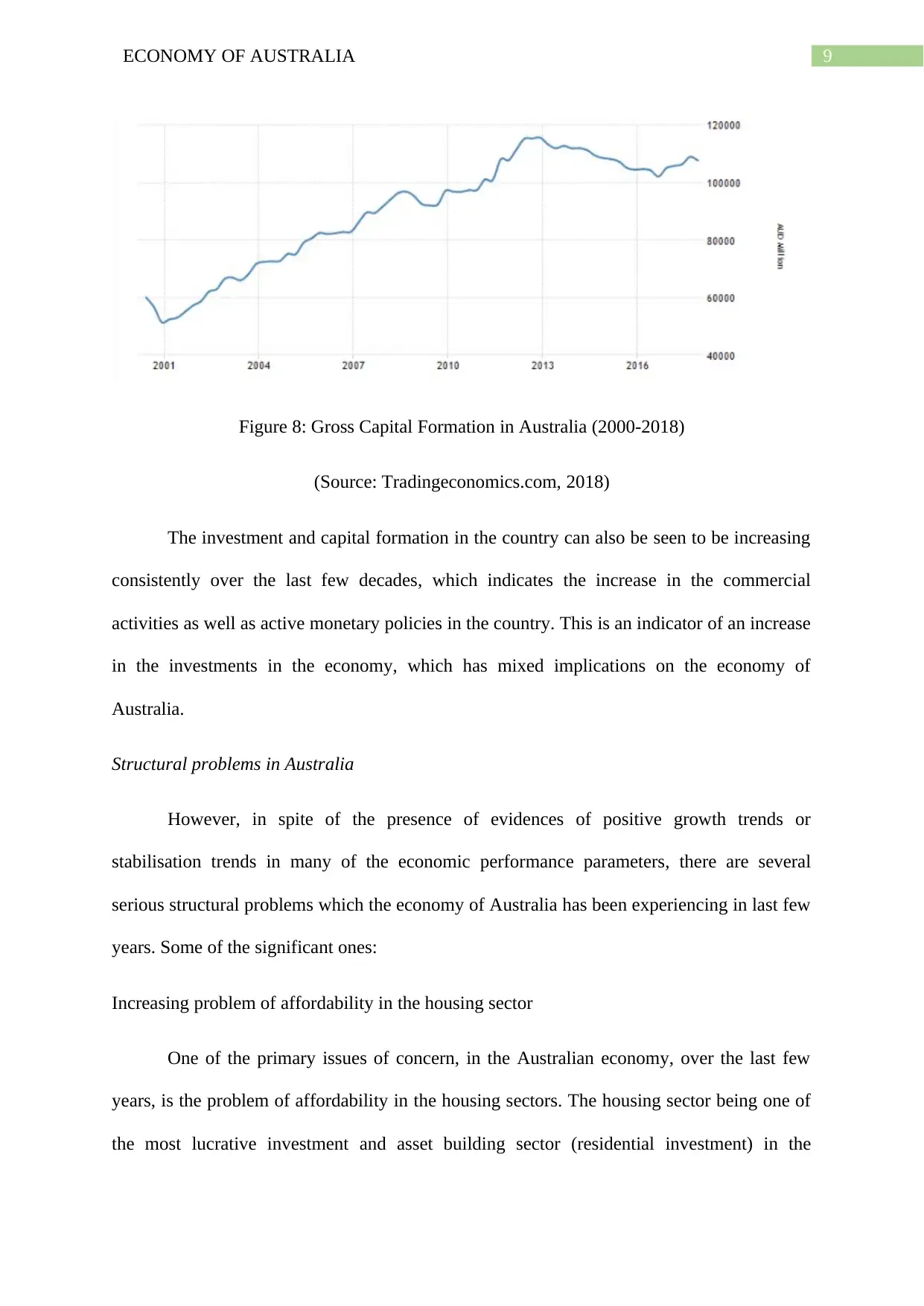
9ECONOMY OF AUSTRALIA
Figure 8: Gross Capital Formation in Australia (2000-2018)
(Source: Tradingeconomics.com, 2018)
The investment and capital formation in the country can also be seen to be increasing
consistently over the last few decades, which indicates the increase in the commercial
activities as well as active monetary policies in the country. This is an indicator of an increase
in the investments in the economy, which has mixed implications on the economy of
Australia.
Structural problems in Australia
However, in spite of the presence of evidences of positive growth trends or
stabilisation trends in many of the economic performance parameters, there are several
serious structural problems which the economy of Australia has been experiencing in last few
years. Some of the significant ones:
Increasing problem of affordability in the housing sector
One of the primary issues of concern, in the Australian economy, over the last few
years, is the problem of affordability in the housing sectors. The housing sector being one of
the most lucrative investment and asset building sector (residential investment) in the
Figure 8: Gross Capital Formation in Australia (2000-2018)
(Source: Tradingeconomics.com, 2018)
The investment and capital formation in the country can also be seen to be increasing
consistently over the last few decades, which indicates the increase in the commercial
activities as well as active monetary policies in the country. This is an indicator of an increase
in the investments in the economy, which has mixed implications on the economy of
Australia.
Structural problems in Australia
However, in spite of the presence of evidences of positive growth trends or
stabilisation trends in many of the economic performance parameters, there are several
serious structural problems which the economy of Australia has been experiencing in last few
years. Some of the significant ones:
Increasing problem of affordability in the housing sector
One of the primary issues of concern, in the Australian economy, over the last few
years, is the problem of affordability in the housing sectors. The housing sector being one of
the most lucrative investment and asset building sector (residential investment) in the
Secure Best Marks with AI Grader
Need help grading? Try our AI Grader for instant feedback on your assignments.
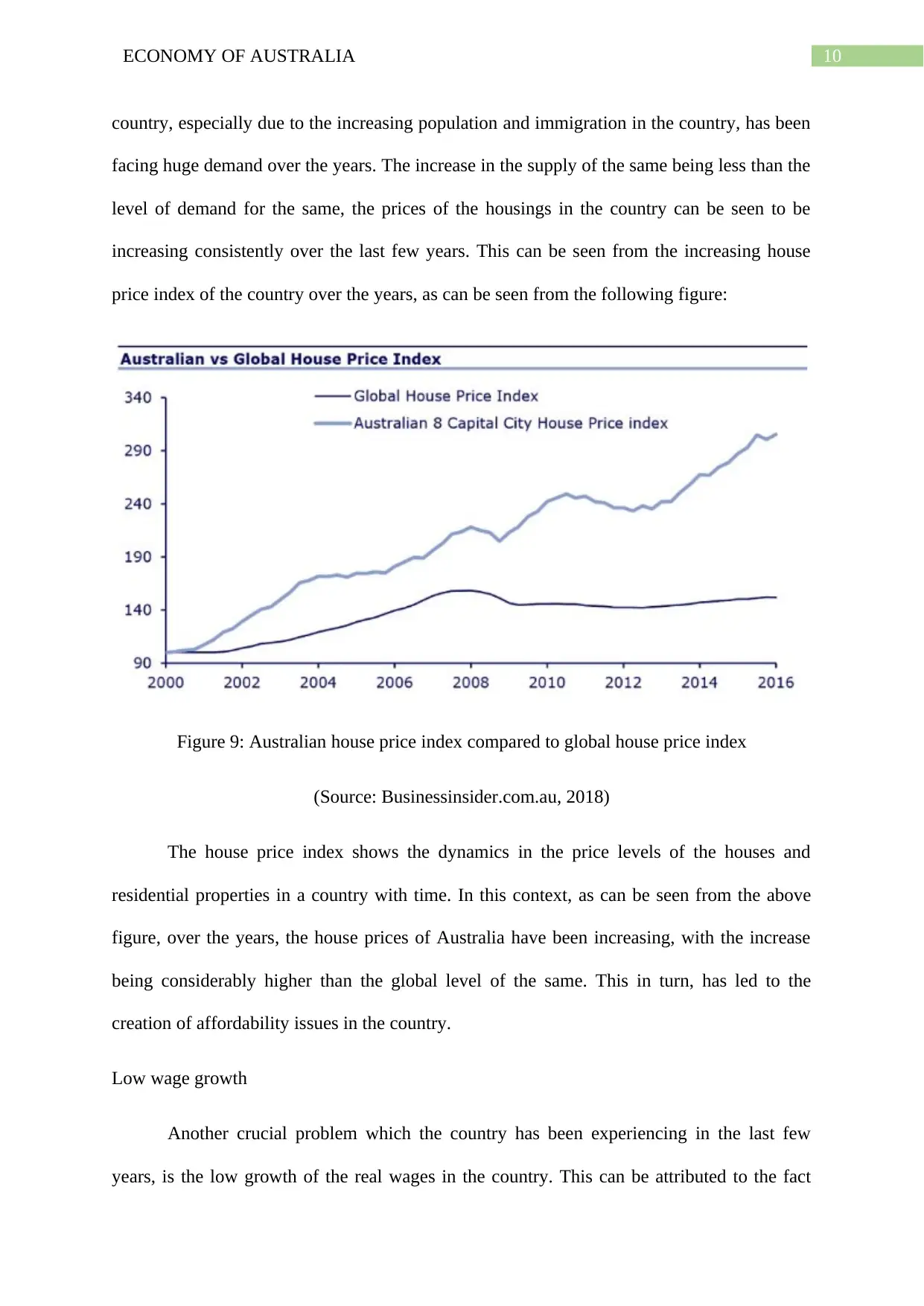
10ECONOMY OF AUSTRALIA
country, especially due to the increasing population and immigration in the country, has been
facing huge demand over the years. The increase in the supply of the same being less than the
level of demand for the same, the prices of the housings in the country can be seen to be
increasing consistently over the last few years. This can be seen from the increasing house
price index of the country over the years, as can be seen from the following figure:
Figure 9: Australian house price index compared to global house price index
(Source: Businessinsider.com.au, 2018)
The house price index shows the dynamics in the price levels of the houses and
residential properties in a country with time. In this context, as can be seen from the above
figure, over the years, the house prices of Australia have been increasing, with the increase
being considerably higher than the global level of the same. This in turn, has led to the
creation of affordability issues in the country.
Low wage growth
Another crucial problem which the country has been experiencing in the last few
years, is the low growth of the real wages in the country. This can be attributed to the fact
country, especially due to the increasing population and immigration in the country, has been
facing huge demand over the years. The increase in the supply of the same being less than the
level of demand for the same, the prices of the housings in the country can be seen to be
increasing consistently over the last few years. This can be seen from the increasing house
price index of the country over the years, as can be seen from the following figure:
Figure 9: Australian house price index compared to global house price index
(Source: Businessinsider.com.au, 2018)
The house price index shows the dynamics in the price levels of the houses and
residential properties in a country with time. In this context, as can be seen from the above
figure, over the years, the house prices of Australia have been increasing, with the increase
being considerably higher than the global level of the same. This in turn, has led to the
creation of affordability issues in the country.
Low wage growth
Another crucial problem which the country has been experiencing in the last few
years, is the low growth of the real wages in the country. This can be attributed to the fact
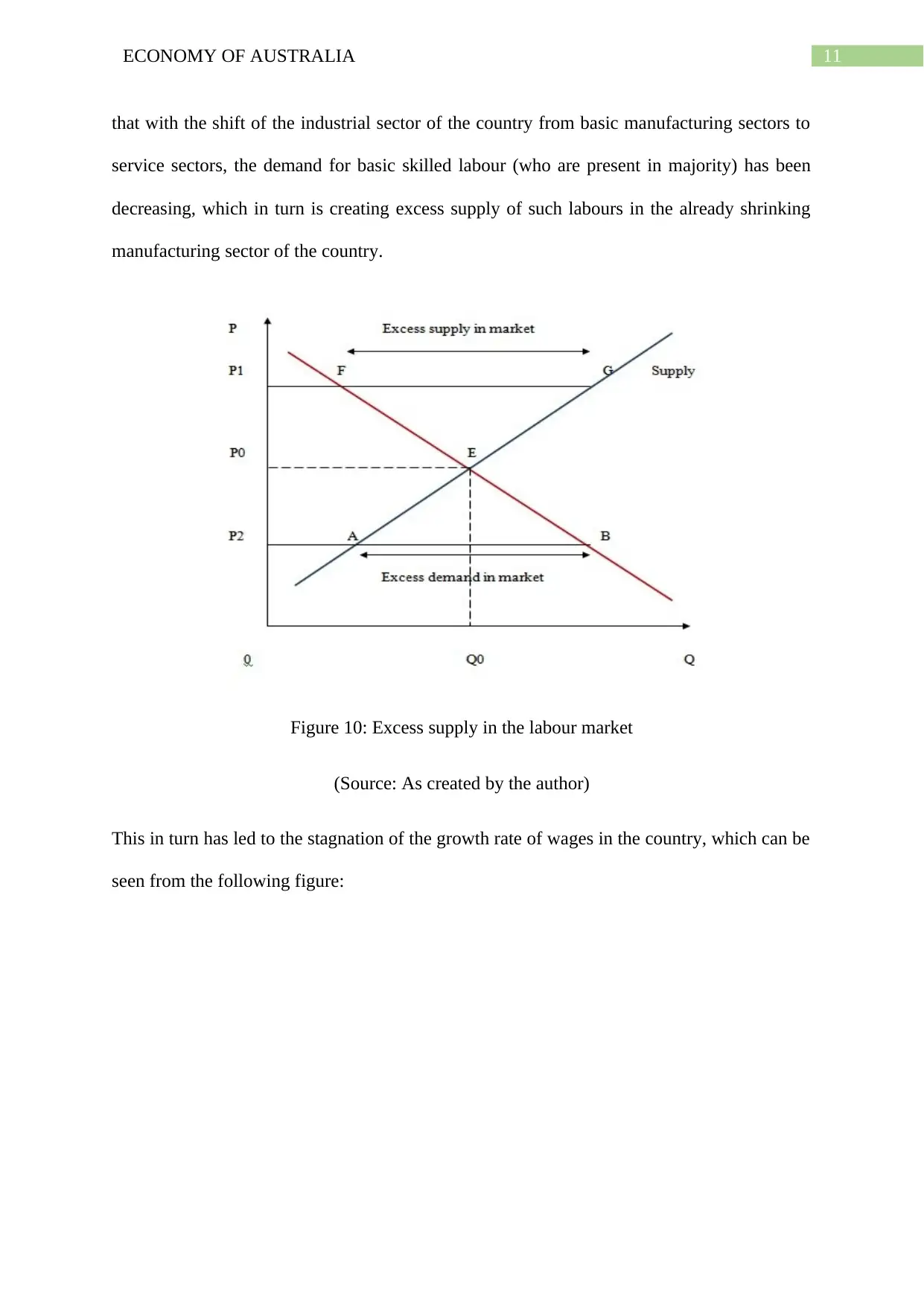
11ECONOMY OF AUSTRALIA
that with the shift of the industrial sector of the country from basic manufacturing sectors to
service sectors, the demand for basic skilled labour (who are present in majority) has been
decreasing, which in turn is creating excess supply of such labours in the already shrinking
manufacturing sector of the country.
Figure 10: Excess supply in the labour market
(Source: As created by the author)
This in turn has led to the stagnation of the growth rate of wages in the country, which can be
seen from the following figure:
that with the shift of the industrial sector of the country from basic manufacturing sectors to
service sectors, the demand for basic skilled labour (who are present in majority) has been
decreasing, which in turn is creating excess supply of such labours in the already shrinking
manufacturing sector of the country.
Figure 10: Excess supply in the labour market
(Source: As created by the author)
This in turn has led to the stagnation of the growth rate of wages in the country, which can be
seen from the following figure:
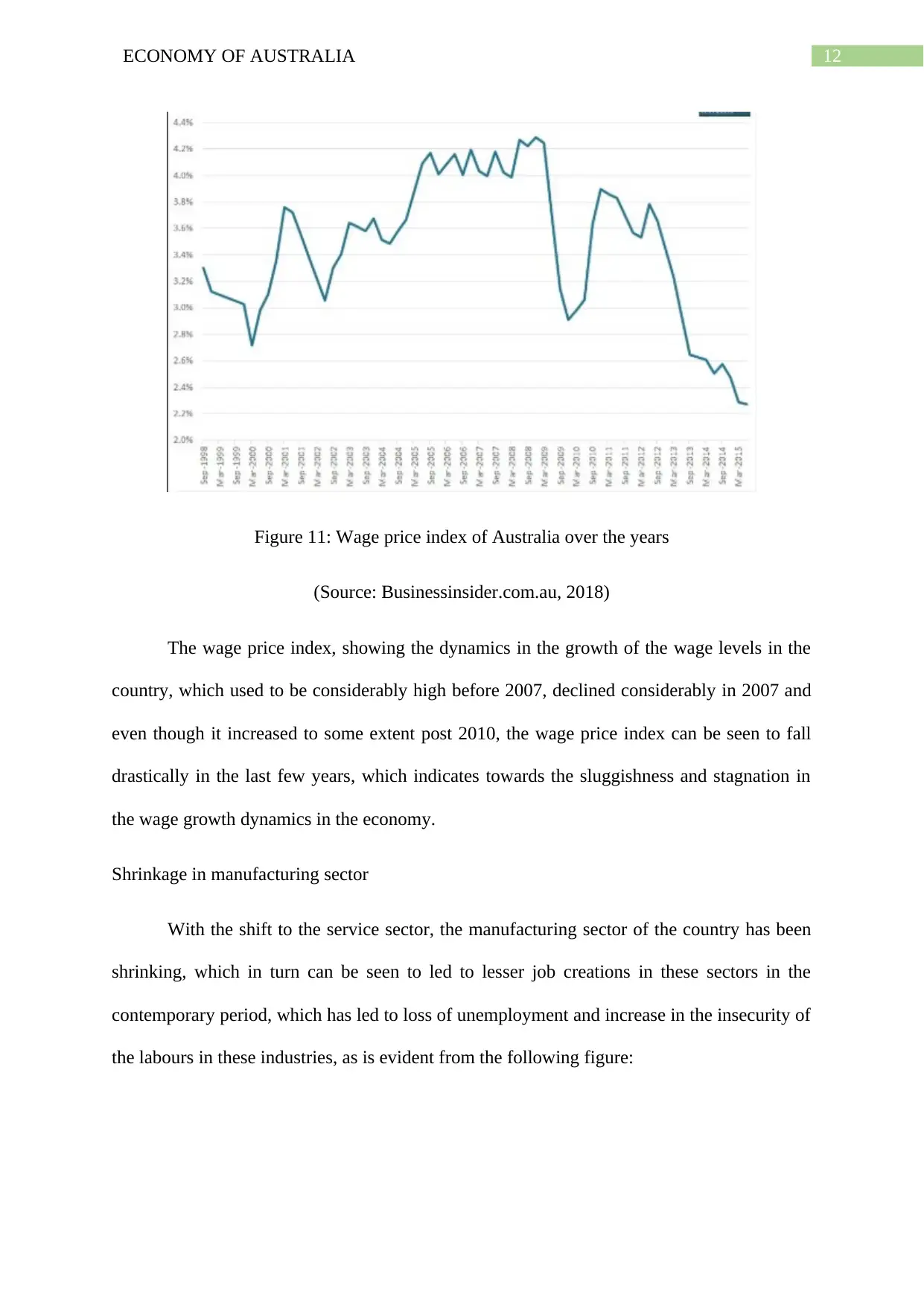
12ECONOMY OF AUSTRALIA
Figure 11: Wage price index of Australia over the years
(Source: Businessinsider.com.au, 2018)
The wage price index, showing the dynamics in the growth of the wage levels in the
country, which used to be considerably high before 2007, declined considerably in 2007 and
even though it increased to some extent post 2010, the wage price index can be seen to fall
drastically in the last few years, which indicates towards the sluggishness and stagnation in
the wage growth dynamics in the economy.
Shrinkage in manufacturing sector
With the shift to the service sector, the manufacturing sector of the country has been
shrinking, which in turn can be seen to led to lesser job creations in these sectors in the
contemporary period, which has led to loss of unemployment and increase in the insecurity of
the labours in these industries, as is evident from the following figure:
Figure 11: Wage price index of Australia over the years
(Source: Businessinsider.com.au, 2018)
The wage price index, showing the dynamics in the growth of the wage levels in the
country, which used to be considerably high before 2007, declined considerably in 2007 and
even though it increased to some extent post 2010, the wage price index can be seen to fall
drastically in the last few years, which indicates towards the sluggishness and stagnation in
the wage growth dynamics in the economy.
Shrinkage in manufacturing sector
With the shift to the service sector, the manufacturing sector of the country has been
shrinking, which in turn can be seen to led to lesser job creations in these sectors in the
contemporary period, which has led to loss of unemployment and increase in the insecurity of
the labours in these industries, as is evident from the following figure:
Paraphrase This Document
Need a fresh take? Get an instant paraphrase of this document with our AI Paraphraser
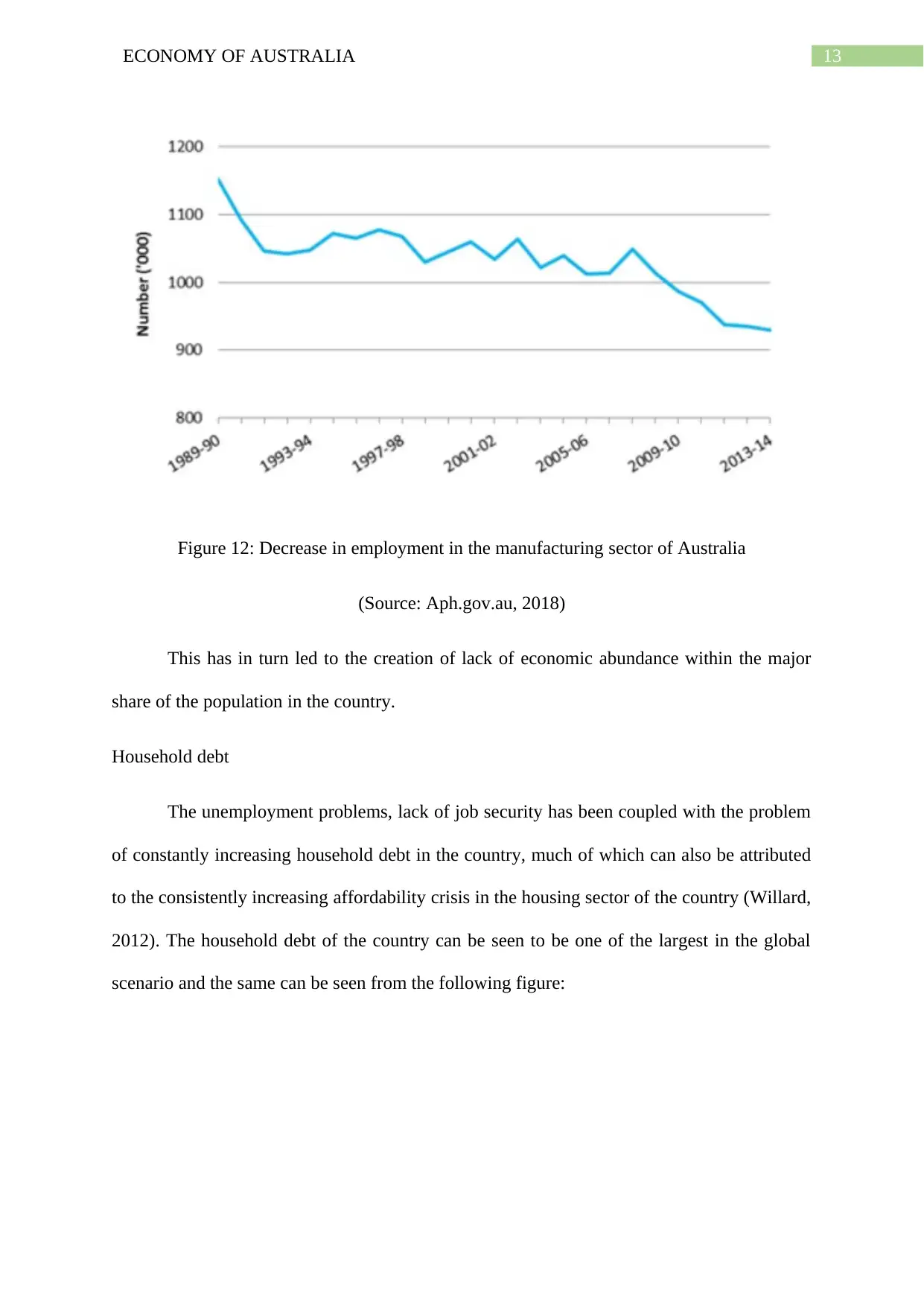
13ECONOMY OF AUSTRALIA
Figure 12: Decrease in employment in the manufacturing sector of Australia
(Source: Aph.gov.au, 2018)
This has in turn led to the creation of lack of economic abundance within the major
share of the population in the country.
Household debt
The unemployment problems, lack of job security has been coupled with the problem
of constantly increasing household debt in the country, much of which can also be attributed
to the consistently increasing affordability crisis in the housing sector of the country (Willard,
2012). The household debt of the country can be seen to be one of the largest in the global
scenario and the same can be seen from the following figure:
Figure 12: Decrease in employment in the manufacturing sector of Australia
(Source: Aph.gov.au, 2018)
This has in turn led to the creation of lack of economic abundance within the major
share of the population in the country.
Household debt
The unemployment problems, lack of job security has been coupled with the problem
of constantly increasing household debt in the country, much of which can also be attributed
to the consistently increasing affordability crisis in the housing sector of the country (Willard,
2012). The household debt of the country can be seen to be one of the largest in the global
scenario and the same can be seen from the following figure:
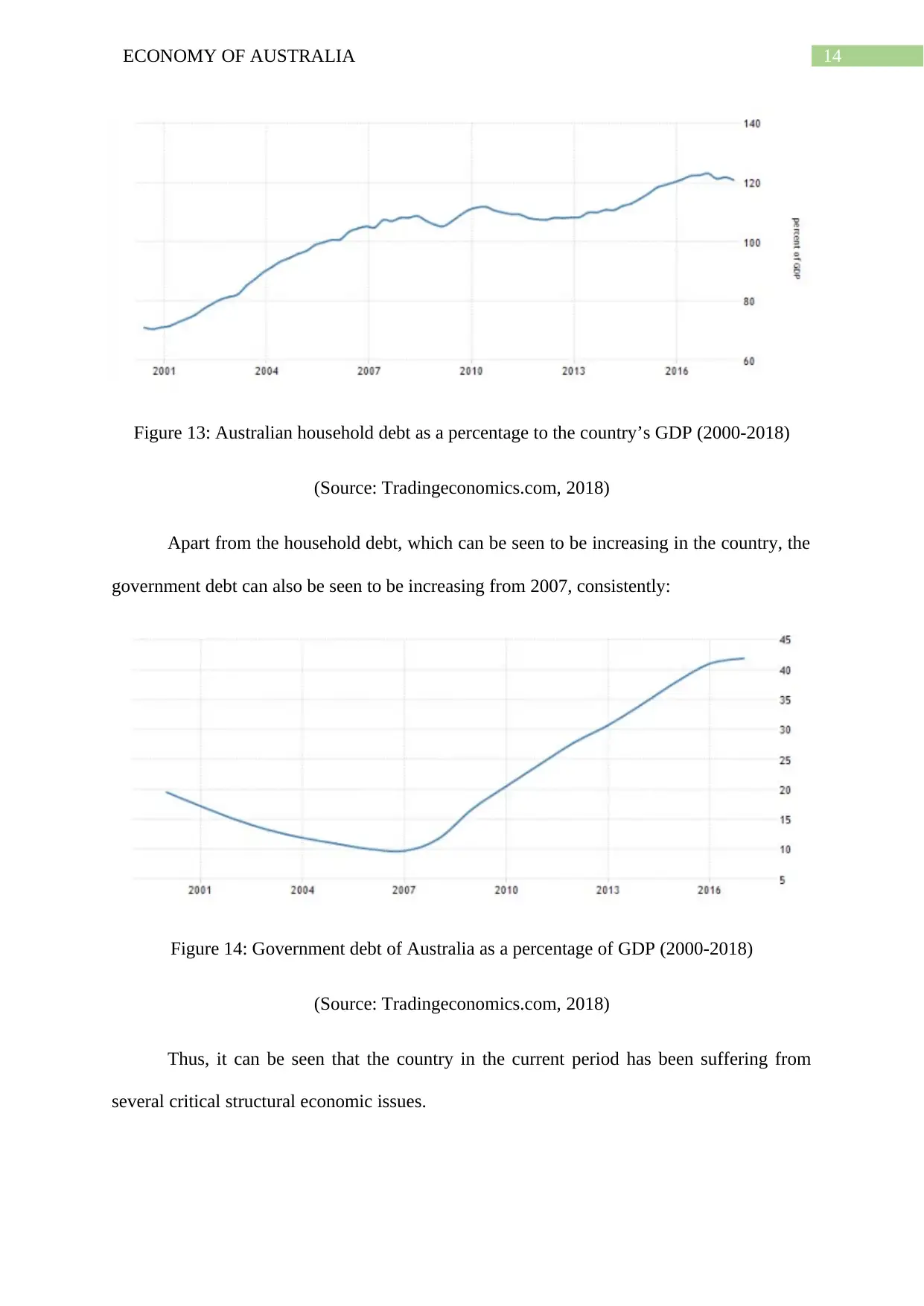
14ECONOMY OF AUSTRALIA
Figure 13: Australian household debt as a percentage to the country’s GDP (2000-2018)
(Source: Tradingeconomics.com, 2018)
Apart from the household debt, which can be seen to be increasing in the country, the
government debt can also be seen to be increasing from 2007, consistently:
Figure 14: Government debt of Australia as a percentage of GDP (2000-2018)
(Source: Tradingeconomics.com, 2018)
Thus, it can be seen that the country in the current period has been suffering from
several critical structural economic issues.
Figure 13: Australian household debt as a percentage to the country’s GDP (2000-2018)
(Source: Tradingeconomics.com, 2018)
Apart from the household debt, which can be seen to be increasing in the country, the
government debt can also be seen to be increasing from 2007, consistently:
Figure 14: Government debt of Australia as a percentage of GDP (2000-2018)
(Source: Tradingeconomics.com, 2018)
Thus, it can be seen that the country in the current period has been suffering from
several critical structural economic issues.
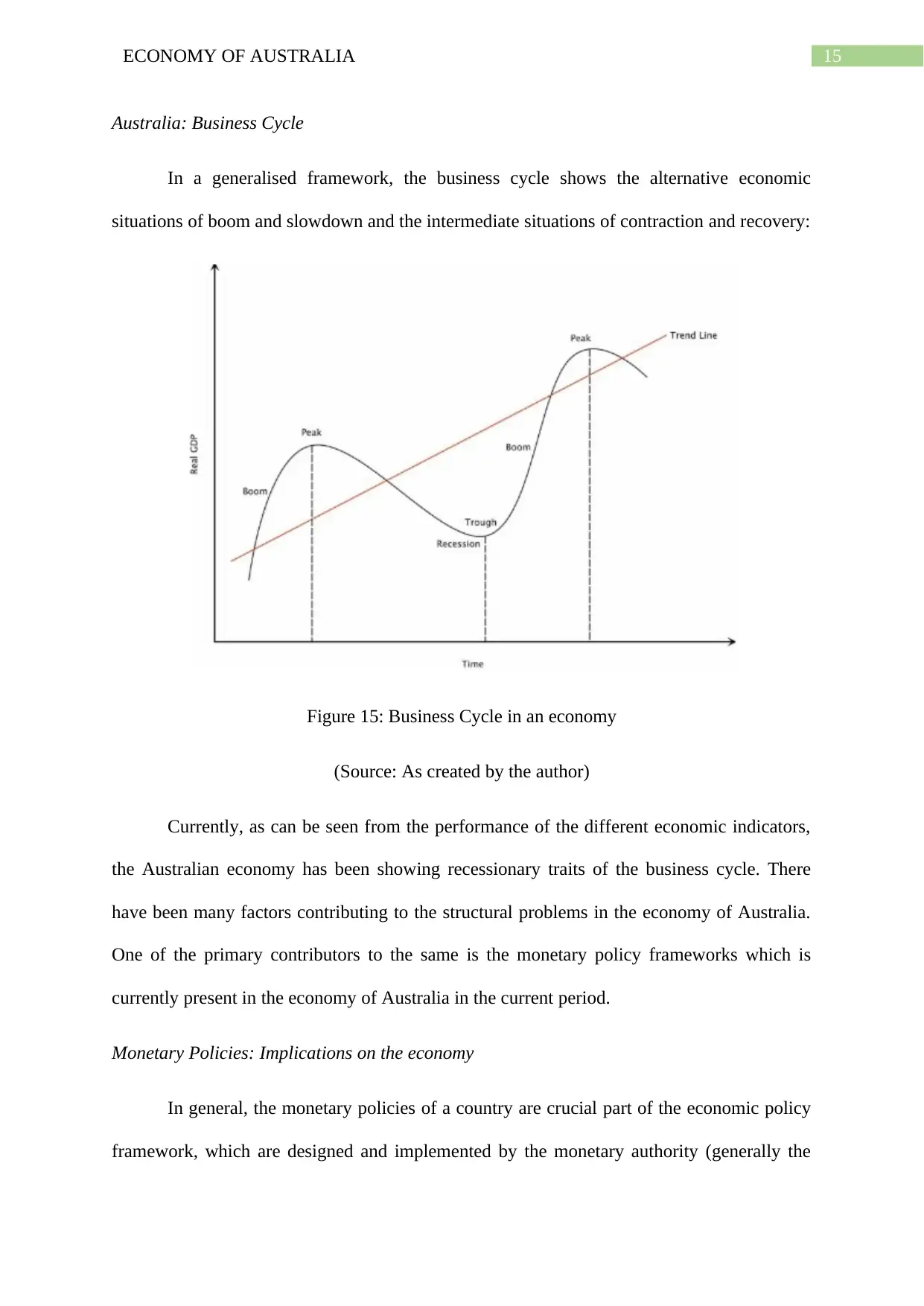
15ECONOMY OF AUSTRALIA
Australia: Business Cycle
In a generalised framework, the business cycle shows the alternative economic
situations of boom and slowdown and the intermediate situations of contraction and recovery:
Figure 15: Business Cycle in an economy
(Source: As created by the author)
Currently, as can be seen from the performance of the different economic indicators,
the Australian economy has been showing recessionary traits of the business cycle. There
have been many factors contributing to the structural problems in the economy of Australia.
One of the primary contributors to the same is the monetary policy frameworks which is
currently present in the economy of Australia in the current period.
Monetary Policies: Implications on the economy
In general, the monetary policies of a country are crucial part of the economic policy
framework, which are designed and implemented by the monetary authority (generally the
Australia: Business Cycle
In a generalised framework, the business cycle shows the alternative economic
situations of boom and slowdown and the intermediate situations of contraction and recovery:
Figure 15: Business Cycle in an economy
(Source: As created by the author)
Currently, as can be seen from the performance of the different economic indicators,
the Australian economy has been showing recessionary traits of the business cycle. There
have been many factors contributing to the structural problems in the economy of Australia.
One of the primary contributors to the same is the monetary policy frameworks which is
currently present in the economy of Australia in the current period.
Monetary Policies: Implications on the economy
In general, the monetary policies of a country are crucial part of the economic policy
framework, which are designed and implemented by the monetary authority (generally the
Secure Best Marks with AI Grader
Need help grading? Try our AI Grader for instant feedback on your assignments.
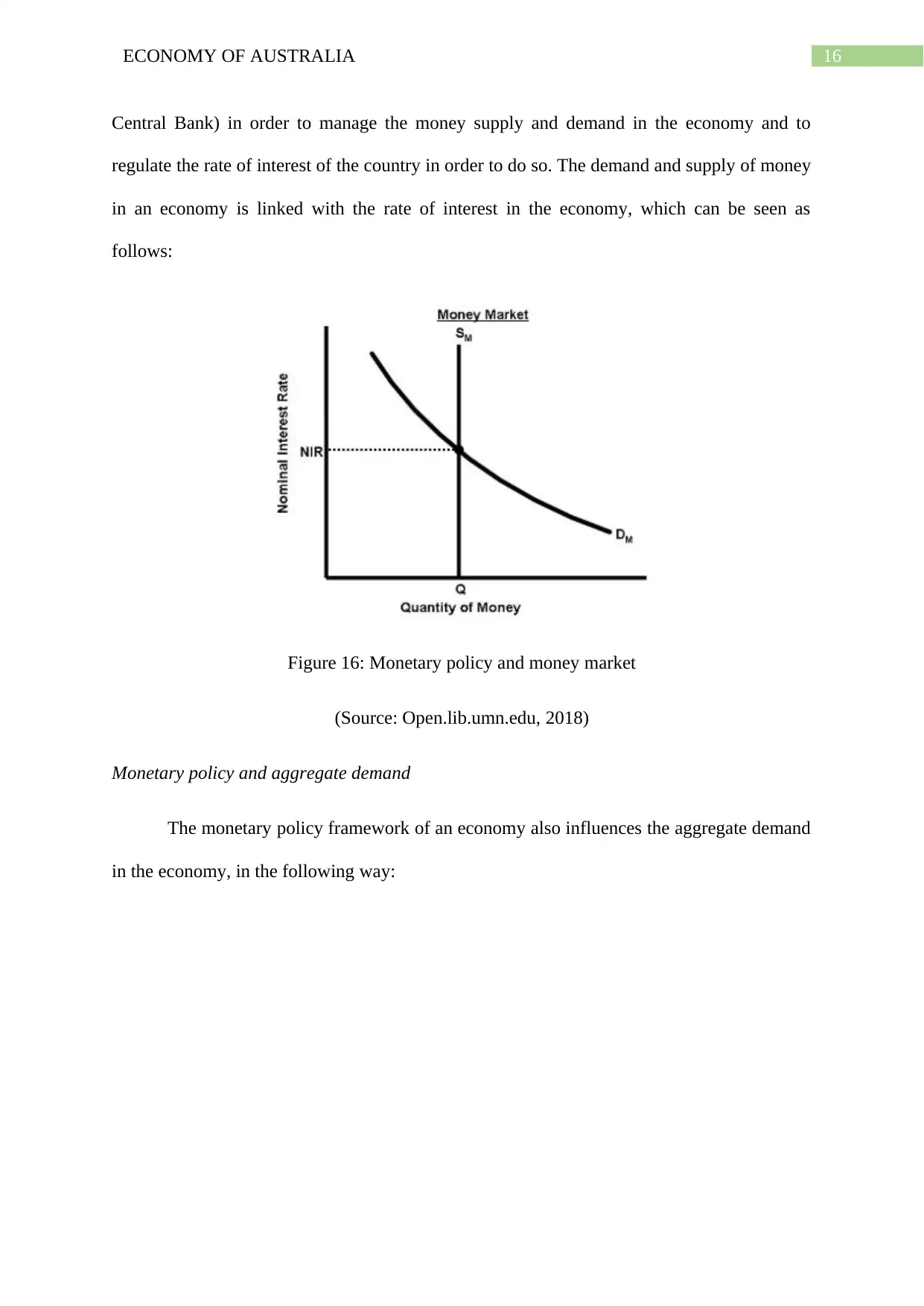
16ECONOMY OF AUSTRALIA
Central Bank) in order to manage the money supply and demand in the economy and to
regulate the rate of interest of the country in order to do so. The demand and supply of money
in an economy is linked with the rate of interest in the economy, which can be seen as
follows:
Figure 16: Monetary policy and money market
(Source: Open.lib.umn.edu, 2018)
Monetary policy and aggregate demand
The monetary policy framework of an economy also influences the aggregate demand
in the economy, in the following way:
Central Bank) in order to manage the money supply and demand in the economy and to
regulate the rate of interest of the country in order to do so. The demand and supply of money
in an economy is linked with the rate of interest in the economy, which can be seen as
follows:
Figure 16: Monetary policy and money market
(Source: Open.lib.umn.edu, 2018)
Monetary policy and aggregate demand
The monetary policy framework of an economy also influences the aggregate demand
in the economy, in the following way:

17ECONOMY OF AUSTRALIA
Figure 17: Monetary policy and aggregate demand
(Source: Voer.edu.vn, 2018)
When attributed to the monetary policy, the rate of interest increases, this leads to a
decrease in the level of investment or consumption and an increase in the savings which in
turn leads to a decrease in the aggregate demand in the economy and vice versa. On the other
hand, apart from targeting the interest rate, the monetary policy framework also involves
targeting the money supply in the economy, which influences the aggregate demand as
follows:
Figure 18: Money supply and aggregate demand
(Source: Voer.edu.vn, 2018)
Figure 17: Monetary policy and aggregate demand
(Source: Voer.edu.vn, 2018)
When attributed to the monetary policy, the rate of interest increases, this leads to a
decrease in the level of investment or consumption and an increase in the savings which in
turn leads to a decrease in the aggregate demand in the economy and vice versa. On the other
hand, apart from targeting the interest rate, the monetary policy framework also involves
targeting the money supply in the economy, which influences the aggregate demand as
follows:
Figure 18: Money supply and aggregate demand
(Source: Voer.edu.vn, 2018)
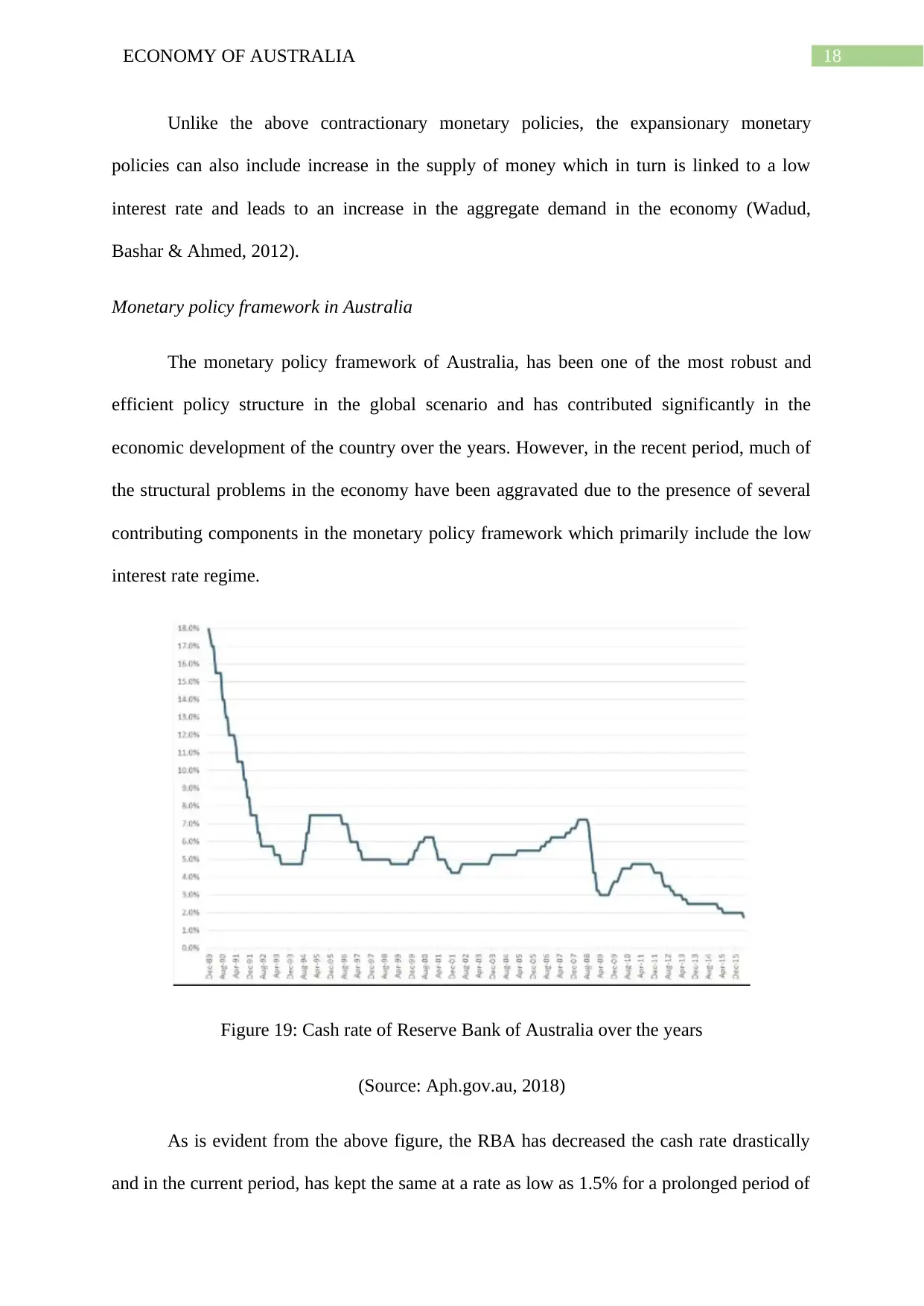
18ECONOMY OF AUSTRALIA
Unlike the above contractionary monetary policies, the expansionary monetary
policies can also include increase in the supply of money which in turn is linked to a low
interest rate and leads to an increase in the aggregate demand in the economy (Wadud,
Bashar & Ahmed, 2012).
Monetary policy framework in Australia
The monetary policy framework of Australia, has been one of the most robust and
efficient policy structure in the global scenario and has contributed significantly in the
economic development of the country over the years. However, in the recent period, much of
the structural problems in the economy have been aggravated due to the presence of several
contributing components in the monetary policy framework which primarily include the low
interest rate regime.
Figure 19: Cash rate of Reserve Bank of Australia over the years
(Source: Aph.gov.au, 2018)
As is evident from the above figure, the RBA has decreased the cash rate drastically
and in the current period, has kept the same at a rate as low as 1.5% for a prolonged period of
Unlike the above contractionary monetary policies, the expansionary monetary
policies can also include increase in the supply of money which in turn is linked to a low
interest rate and leads to an increase in the aggregate demand in the economy (Wadud,
Bashar & Ahmed, 2012).
Monetary policy framework in Australia
The monetary policy framework of Australia, has been one of the most robust and
efficient policy structure in the global scenario and has contributed significantly in the
economic development of the country over the years. However, in the recent period, much of
the structural problems in the economy have been aggravated due to the presence of several
contributing components in the monetary policy framework which primarily include the low
interest rate regime.
Figure 19: Cash rate of Reserve Bank of Australia over the years
(Source: Aph.gov.au, 2018)
As is evident from the above figure, the RBA has decreased the cash rate drastically
and in the current period, has kept the same at a rate as low as 1.5% for a prolonged period of
Paraphrase This Document
Need a fresh take? Get an instant paraphrase of this document with our AI Paraphraser
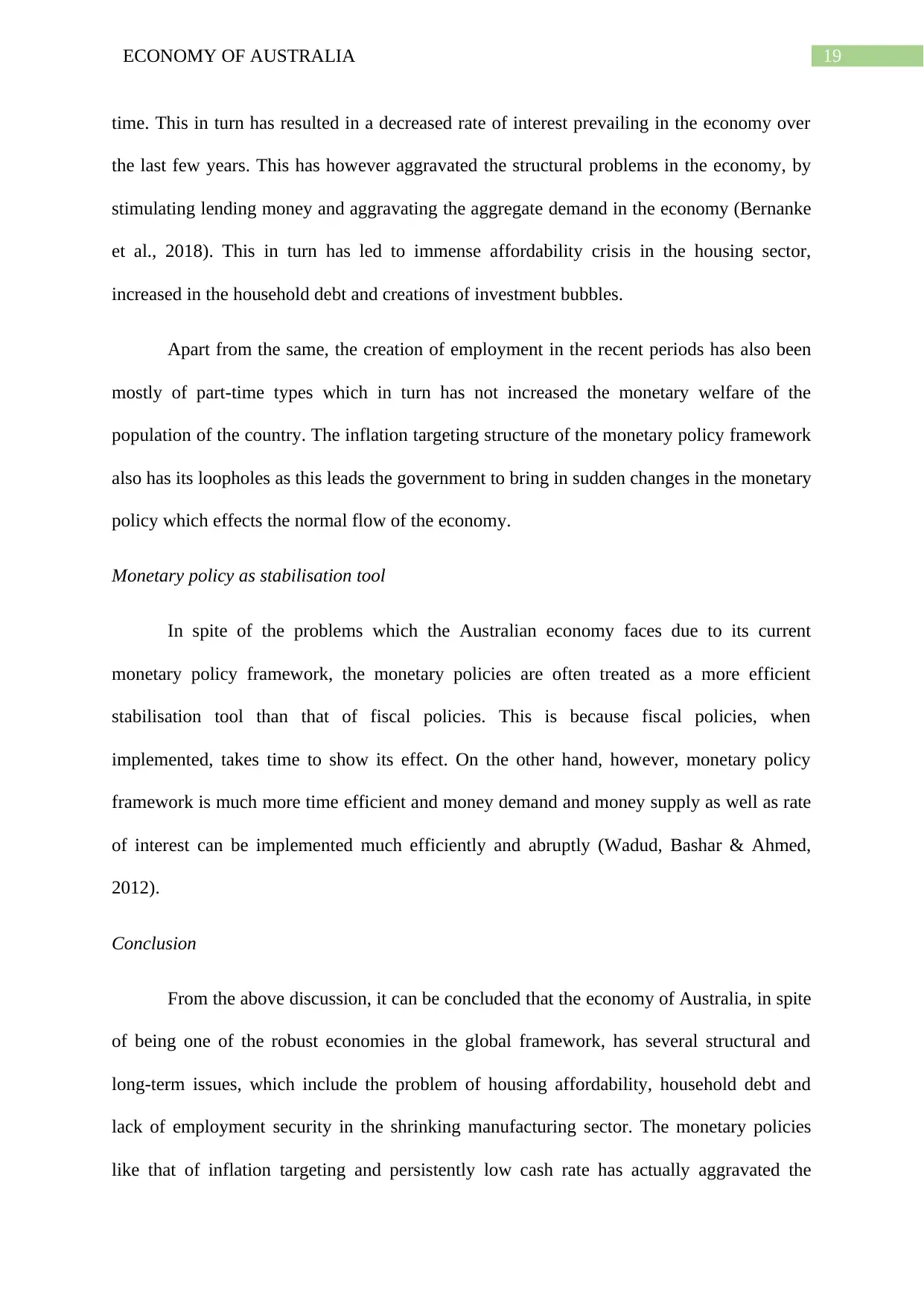
19ECONOMY OF AUSTRALIA
time. This in turn has resulted in a decreased rate of interest prevailing in the economy over
the last few years. This has however aggravated the structural problems in the economy, by
stimulating lending money and aggravating the aggregate demand in the economy (Bernanke
et al., 2018). This in turn has led to immense affordability crisis in the housing sector,
increased in the household debt and creations of investment bubbles.
Apart from the same, the creation of employment in the recent periods has also been
mostly of part-time types which in turn has not increased the monetary welfare of the
population of the country. The inflation targeting structure of the monetary policy framework
also has its loopholes as this leads the government to bring in sudden changes in the monetary
policy which effects the normal flow of the economy.
Monetary policy as stabilisation tool
In spite of the problems which the Australian economy faces due to its current
monetary policy framework, the monetary policies are often treated as a more efficient
stabilisation tool than that of fiscal policies. This is because fiscal policies, when
implemented, takes time to show its effect. On the other hand, however, monetary policy
framework is much more time efficient and money demand and money supply as well as rate
of interest can be implemented much efficiently and abruptly (Wadud, Bashar & Ahmed,
2012).
Conclusion
From the above discussion, it can be concluded that the economy of Australia, in spite
of being one of the robust economies in the global framework, has several structural and
long-term issues, which include the problem of housing affordability, household debt and
lack of employment security in the shrinking manufacturing sector. The monetary policies
like that of inflation targeting and persistently low cash rate has actually aggravated the
time. This in turn has resulted in a decreased rate of interest prevailing in the economy over
the last few years. This has however aggravated the structural problems in the economy, by
stimulating lending money and aggravating the aggregate demand in the economy (Bernanke
et al., 2018). This in turn has led to immense affordability crisis in the housing sector,
increased in the household debt and creations of investment bubbles.
Apart from the same, the creation of employment in the recent periods has also been
mostly of part-time types which in turn has not increased the monetary welfare of the
population of the country. The inflation targeting structure of the monetary policy framework
also has its loopholes as this leads the government to bring in sudden changes in the monetary
policy which effects the normal flow of the economy.
Monetary policy as stabilisation tool
In spite of the problems which the Australian economy faces due to its current
monetary policy framework, the monetary policies are often treated as a more efficient
stabilisation tool than that of fiscal policies. This is because fiscal policies, when
implemented, takes time to show its effect. On the other hand, however, monetary policy
framework is much more time efficient and money demand and money supply as well as rate
of interest can be implemented much efficiently and abruptly (Wadud, Bashar & Ahmed,
2012).
Conclusion
From the above discussion, it can be concluded that the economy of Australia, in spite
of being one of the robust economies in the global framework, has several structural and
long-term issues, which include the problem of housing affordability, household debt and
lack of employment security in the shrinking manufacturing sector. The monetary policies
like that of inflation targeting and persistently low cash rate has actually aggravated the

20ECONOMY OF AUSTRALIA
structural problems in the economy. However, in spite of these, the monetary policy
framework is more efficient and abrupt stabilisation tool than the fiscal policies as the former
policies are more efficient and abrupt than the latter ones. However, Australia needs to shift
its emphasis from inflation targeting only to other monetary strategies which may help in
decreasing the borrowing tendencies of the population of the economy, thereby decreasing
the problems of rising debt and housing affordability crisis occurring in the economy.
structural problems in the economy. However, in spite of these, the monetary policy
framework is more efficient and abrupt stabilisation tool than the fiscal policies as the former
policies are more efficient and abrupt than the latter ones. However, Australia needs to shift
its emphasis from inflation targeting only to other monetary strategies which may help in
decreasing the borrowing tendencies of the population of the economy, thereby decreasing
the problems of rising debt and housing affordability crisis occurring in the economy.

21ECONOMY OF AUSTRALIA
References
Agénor, P. R., & Montiel, P. J. (2015). Development macroeconomics. Princeton University
Press.
Aph.gov.au. (2018). Performance of manufacturing industry: a quick guide – Parliament of
Australia. Retrieved from
https://www.aph.gov.au/About_Parliament/Parliamentary_Departments/
Parliamentary_Library/pubs/rp/rp1415/Quick_Guides/Manufacturing
Australia Balance of Trade | 1971-2018 | Data | Chart | Calendar | Forecast.
(2018). Tradingeconomics.com. Retrieved 3 June 2018, from
https://tradingeconomics.com/australia/balance-of-trade
Australia Consumer Spending | 1959-2018 | Data | Chart | Calendar.
(2018). Tradingeconomics.com. Retrieved 3 June 2018, from
https://tradingeconomics.com/australia/consumer-spending
Australia Exports | 1971-2018 | Data | Chart | Calendar | Forecast | News.
(2018). Tradingeconomics.com. Retrieved 3 June 2018, from
https://tradingeconomics.com/australia/exports
Australia GDP | 1960-2018 | Data | Chart | Calendar | Forecast | News.
(2018). Tradingeconomics.com. Retrieved 3 June 2018, from
https://tradingeconomics.com/australia/gdp
Australia GDP Growth Rate | 1959-2018 | Data | Chart | Calendar | Forecast.
(2018). Tradingeconomics.com. Retrieved 3 June 2018, from
https://tradingeconomics.com/australia/gdp-growth
References
Agénor, P. R., & Montiel, P. J. (2015). Development macroeconomics. Princeton University
Press.
Aph.gov.au. (2018). Performance of manufacturing industry: a quick guide – Parliament of
Australia. Retrieved from
https://www.aph.gov.au/About_Parliament/Parliamentary_Departments/
Parliamentary_Library/pubs/rp/rp1415/Quick_Guides/Manufacturing
Australia Balance of Trade | 1971-2018 | Data | Chart | Calendar | Forecast.
(2018). Tradingeconomics.com. Retrieved 3 June 2018, from
https://tradingeconomics.com/australia/balance-of-trade
Australia Consumer Spending | 1959-2018 | Data | Chart | Calendar.
(2018). Tradingeconomics.com. Retrieved 3 June 2018, from
https://tradingeconomics.com/australia/consumer-spending
Australia Exports | 1971-2018 | Data | Chart | Calendar | Forecast | News.
(2018). Tradingeconomics.com. Retrieved 3 June 2018, from
https://tradingeconomics.com/australia/exports
Australia GDP | 1960-2018 | Data | Chart | Calendar | Forecast | News.
(2018). Tradingeconomics.com. Retrieved 3 June 2018, from
https://tradingeconomics.com/australia/gdp
Australia GDP Growth Rate | 1959-2018 | Data | Chart | Calendar | Forecast.
(2018). Tradingeconomics.com. Retrieved 3 June 2018, from
https://tradingeconomics.com/australia/gdp-growth
Secure Best Marks with AI Grader
Need help grading? Try our AI Grader for instant feedback on your assignments.
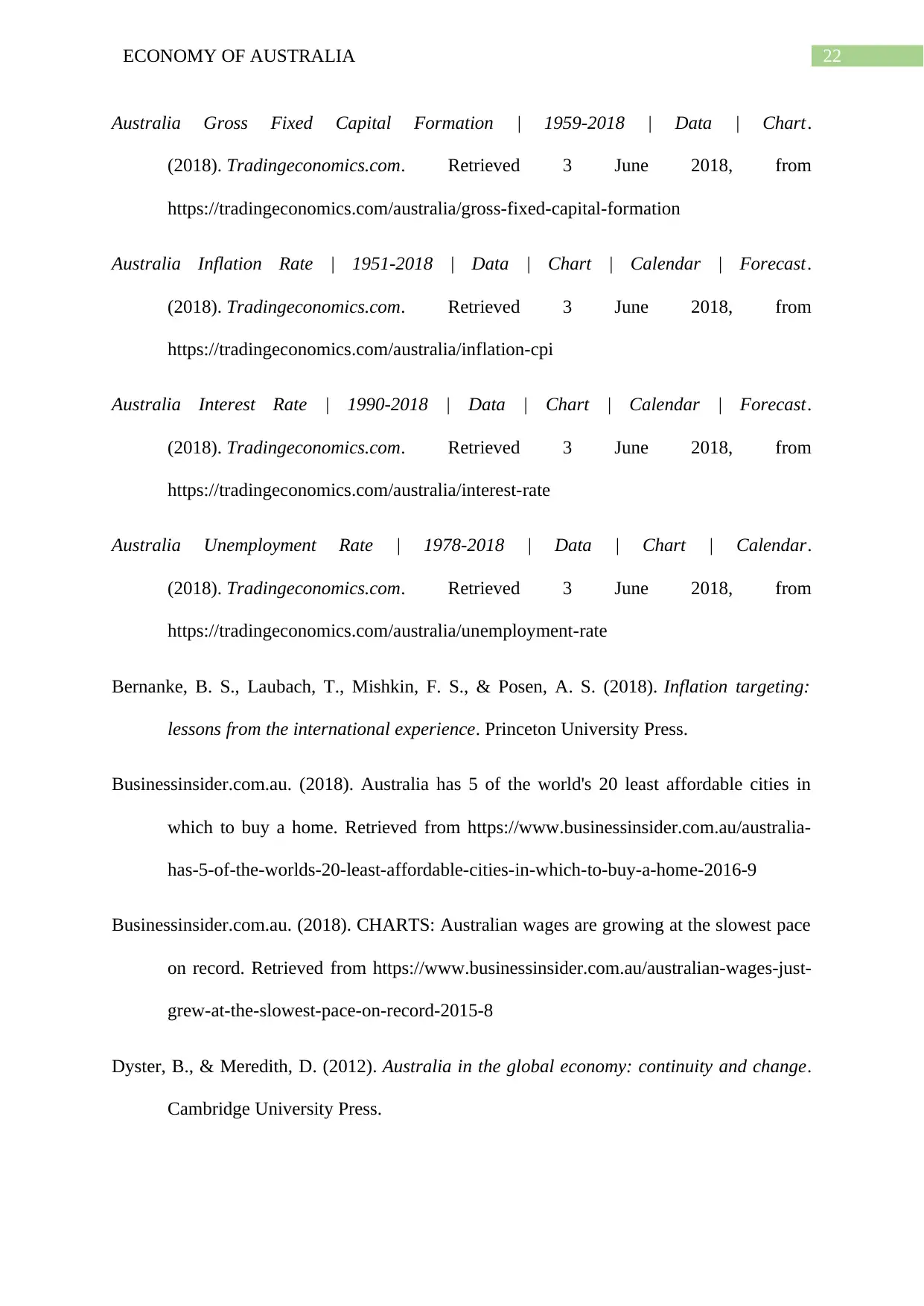
22ECONOMY OF AUSTRALIA
Australia Gross Fixed Capital Formation | 1959-2018 | Data | Chart.
(2018). Tradingeconomics.com. Retrieved 3 June 2018, from
https://tradingeconomics.com/australia/gross-fixed-capital-formation
Australia Inflation Rate | 1951-2018 | Data | Chart | Calendar | Forecast.
(2018). Tradingeconomics.com. Retrieved 3 June 2018, from
https://tradingeconomics.com/australia/inflation-cpi
Australia Interest Rate | 1990-2018 | Data | Chart | Calendar | Forecast.
(2018). Tradingeconomics.com. Retrieved 3 June 2018, from
https://tradingeconomics.com/australia/interest-rate
Australia Unemployment Rate | 1978-2018 | Data | Chart | Calendar.
(2018). Tradingeconomics.com. Retrieved 3 June 2018, from
https://tradingeconomics.com/australia/unemployment-rate
Bernanke, B. S., Laubach, T., Mishkin, F. S., & Posen, A. S. (2018). Inflation targeting:
lessons from the international experience. Princeton University Press.
Businessinsider.com.au. (2018). Australia has 5 of the world's 20 least affordable cities in
which to buy a home. Retrieved from https://www.businessinsider.com.au/australia-
has-5-of-the-worlds-20-least-affordable-cities-in-which-to-buy-a-home-2016-9
Businessinsider.com.au. (2018). CHARTS: Australian wages are growing at the slowest pace
on record. Retrieved from https://www.businessinsider.com.au/australian-wages-just-
grew-at-the-slowest-pace-on-record-2015-8
Dyster, B., & Meredith, D. (2012). Australia in the global economy: continuity and change.
Cambridge University Press.
Australia Gross Fixed Capital Formation | 1959-2018 | Data | Chart.
(2018). Tradingeconomics.com. Retrieved 3 June 2018, from
https://tradingeconomics.com/australia/gross-fixed-capital-formation
Australia Inflation Rate | 1951-2018 | Data | Chart | Calendar | Forecast.
(2018). Tradingeconomics.com. Retrieved 3 June 2018, from
https://tradingeconomics.com/australia/inflation-cpi
Australia Interest Rate | 1990-2018 | Data | Chart | Calendar | Forecast.
(2018). Tradingeconomics.com. Retrieved 3 June 2018, from
https://tradingeconomics.com/australia/interest-rate
Australia Unemployment Rate | 1978-2018 | Data | Chart | Calendar.
(2018). Tradingeconomics.com. Retrieved 3 June 2018, from
https://tradingeconomics.com/australia/unemployment-rate
Bernanke, B. S., Laubach, T., Mishkin, F. S., & Posen, A. S. (2018). Inflation targeting:
lessons from the international experience. Princeton University Press.
Businessinsider.com.au. (2018). Australia has 5 of the world's 20 least affordable cities in
which to buy a home. Retrieved from https://www.businessinsider.com.au/australia-
has-5-of-the-worlds-20-least-affordable-cities-in-which-to-buy-a-home-2016-9
Businessinsider.com.au. (2018). CHARTS: Australian wages are growing at the slowest pace
on record. Retrieved from https://www.businessinsider.com.au/australian-wages-just-
grew-at-the-slowest-pace-on-record-2015-8
Dyster, B., & Meredith, D. (2012). Australia in the global economy: continuity and change.
Cambridge University Press.

23ECONOMY OF AUSTRALIA
Gibson-Graham, J. K., Cameron, J., & Healy, S. (2013). Take back the economy: An ethical
guide for transforming our communities. University of Minnesota Press.
Kumar, S., Webber, D. J., & Perry, G. (2012). Real wages, inflation and labour productivity
in Australia. Applied Economics, 44(23), 2945-2954.
Open.lib.umn.edu. (2018). 25.2 Demand, Supply, and Equilibrium in the Money Market |
Principles of Economics. Retrieved from
https://open.lib.umn.edu/principleseconomics/chapter/25-2-demand-supply-and-
equilibrium-in-the-money-market/
Petit, P. (2013). Slow growth and the service economy. Bloomsbury Publishing.
Rba.gov.au. (2018). Box A Recent Trade Protectionism Measures | Statement on Monetary
Policy – May 2018 | RBA. Retrieved from
https://www.rba.gov.au/publications/smp/2018/may/box-a-recent-trade-
protectionism-measures.html
Tradingeconomics.com. (2018). Australia Government Debt to GDP | 1989-2018 | Data |
Chart | Calendar. Retrieved from https://tradingeconomics.com/australia/government-
debt-to-gdp
Voer.edu.vn. (2018). Macroeconomics: Monetary Policy and Economic Outcomes - VOER.
Retrieved from
http://voer.edu.vn/c/monetary-policy-and-economic-outcomes/7702b485/eff030a9
Wadud, I. M., Bashar, O. H., & Ahmed, H. J. A. (2012). Monetary policy and the housing
market in Australia. Journal of Policy Modeling, 34(6), 849-863.
Gibson-Graham, J. K., Cameron, J., & Healy, S. (2013). Take back the economy: An ethical
guide for transforming our communities. University of Minnesota Press.
Kumar, S., Webber, D. J., & Perry, G. (2012). Real wages, inflation and labour productivity
in Australia. Applied Economics, 44(23), 2945-2954.
Open.lib.umn.edu. (2018). 25.2 Demand, Supply, and Equilibrium in the Money Market |
Principles of Economics. Retrieved from
https://open.lib.umn.edu/principleseconomics/chapter/25-2-demand-supply-and-
equilibrium-in-the-money-market/
Petit, P. (2013). Slow growth and the service economy. Bloomsbury Publishing.
Rba.gov.au. (2018). Box A Recent Trade Protectionism Measures | Statement on Monetary
Policy – May 2018 | RBA. Retrieved from
https://www.rba.gov.au/publications/smp/2018/may/box-a-recent-trade-
protectionism-measures.html
Tradingeconomics.com. (2018). Australia Government Debt to GDP | 1989-2018 | Data |
Chart | Calendar. Retrieved from https://tradingeconomics.com/australia/government-
debt-to-gdp
Voer.edu.vn. (2018). Macroeconomics: Monetary Policy and Economic Outcomes - VOER.
Retrieved from
http://voer.edu.vn/c/monetary-policy-and-economic-outcomes/7702b485/eff030a9
Wadud, I. M., Bashar, O. H., & Ahmed, H. J. A. (2012). Monetary policy and the housing
market in Australia. Journal of Policy Modeling, 34(6), 849-863.
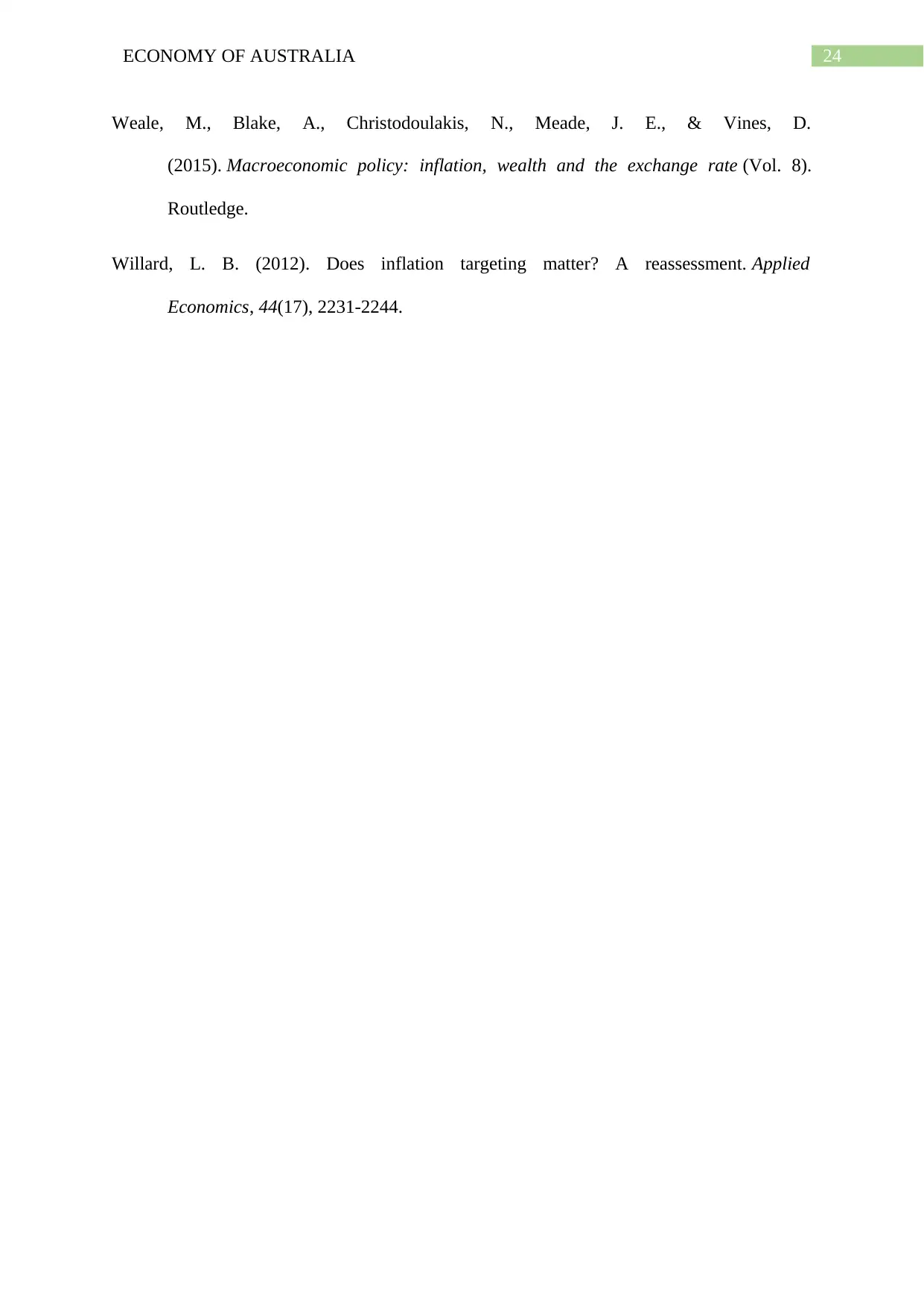
24ECONOMY OF AUSTRALIA
Weale, M., Blake, A., Christodoulakis, N., Meade, J. E., & Vines, D.
(2015). Macroeconomic policy: inflation, wealth and the exchange rate (Vol. 8).
Routledge.
Willard, L. B. (2012). Does inflation targeting matter? A reassessment. Applied
Economics, 44(17), 2231-2244.
Weale, M., Blake, A., Christodoulakis, N., Meade, J. E., & Vines, D.
(2015). Macroeconomic policy: inflation, wealth and the exchange rate (Vol. 8).
Routledge.
Willard, L. B. (2012). Does inflation targeting matter? A reassessment. Applied
Economics, 44(17), 2231-2244.
1 out of 25
Related Documents
Your All-in-One AI-Powered Toolkit for Academic Success.
+13062052269
info@desklib.com
Available 24*7 on WhatsApp / Email
![[object Object]](/_next/static/media/star-bottom.7253800d.svg)
Unlock your academic potential
© 2024 | Zucol Services PVT LTD | All rights reserved.





